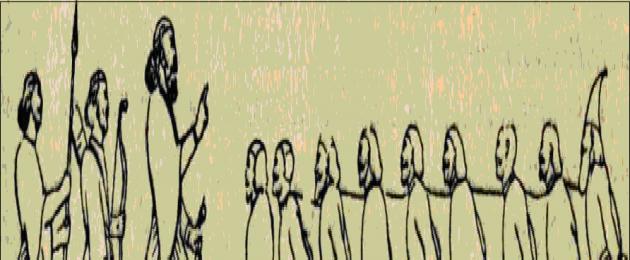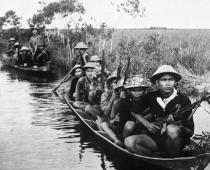Formation of the Persian state.
To the east of Mesopotamia, between the Caspian Sea and the Persian Gulf, lies the vast Iranian Plateau. It is surrounded by mountains on the east and west. In ancient times, the plateau was largely a desert. In the spring, the herds could find food and water in the wells, in the summer they were driven to the mountain pastures.
The plateau was inhabited by numerous tribes of pastoral nomads. Pastoral communities had large herds of sheep, goats, cattle, horses.
The leaders and elders, having great power, disposed of them as they wished. Gradually, communal cattle became the private property of the rich who separated from the community.
The emergence of private property led to the disintegration of the primitive communal system. Along with rich pastoralists, poor people appeared, forced to graze other people's cattle. For grazing livestock, the rich used the labor of slaves, who were obtained in predatory wars with neighboring agricultural or pastoral tribes.
With the division of society into classes, the need for a state arises. The establishment of a strong government was beneficial to wealthy slave-owning cattle breeders who needed to protect their wealth and organize predatory campaigns in other countries.
The first association of the tribes that inhabited the Iranian plateau was created under the leadership of the Medes. In the middle of the VI century. BC e. the leader of the Persian tribe Cyrus manages to defeat the Medes, subjugate other tribes and form a strong state.
Persian conquests.
The greedy eyes of the Persian slave owners were turned to neighboring countries with a dense agricultural population and rich trading cities. Cyrus launches an attack on Babylonia. The capital of the state of Babylon was an impregnable fortress with three rows of walls. But the inhabitants of Babylon did not want to fight the Persians.
There were many foreigners in Babylon who dreamed of returning to their homeland and saw a liberator in the Persian king. The rich Babylonian merchants, dissatisfied with the decline in trade, hoped that Cyrus would open the way for Babylonian goods to distant lands. In 538 BC. e. Babylon was taken by the Persians without a fight. 
After the capture of Babylon, for a number of years Cyrus waged wars in Central Asia against nomadic tribes who attacked the settled agricultural population. The nomads lured Cyrus with an army deep into their territory and defeated the Persians. Cyrus was killed. Most of his troops were destroyed.
Cyrus' conquests were successfully continued by his son Cambyses. In 525 BC. e. he conquered Egypt. After an unsuccessful attempt by Cambyses to subjugate Nubia, uprisings rise in various parts of the Persian state. An impostor appeared in Persia, an Indian priest who took the name of his brother Cambyses, who was killed before going to Egypt. The impostor was supported by other priests - magicians, dissatisfied with the dominance of the Persian slave owners.
Organization of the Persian state.
The struggle of the Medes and other peoples for independence ended in their defeat. King Darius I killed the impostor and, having seized the Persian throne, suppressed uprisings in the countries conquered by the Persians. Darius I expanded the limits of the Persian state in the East and in the West. Under him, the Persian state covered all of South Asia to India and China and part of Africa. There is an inscription carved on a high rock. It tells about the victories of Darius and the greatness of his kingdom.
To maintain Persian domination, Darius I divided the state into separate regions - satrapies. At the head of each satrapy was a special ruler - the satrap, who was in charge of the receipt of taxes and taxes to the royal treasury, attracting the population to military service and forced labor. The satrap was the executor of the will of the king. He was watched by royal spies - "the eyes and ears of the king." In case of violation of the royal order, the satrap was executed or removed.
A huge state needed a good organization of communications and communications. Roads were built connecting the satrapies with the center of the state. At a certain distance from each other there were stations with horses standing ready. Particularly urgent reports were transmitted with the help of lit torches. Good roads contributed to the development of trade.
This was also favored by a minted coin introduced by Darius and called darik. She was minted from gold. Silver and bronze coins were minted in the satrapies. The king tried to connect the Mediterranean with the Red Sea by a canal, but work was stopped with his death.
The Persian king had enormous power. He was called "the ruler of all people from sunrise to sunset." Anyone approaching the king had to fall at his feet. The king had several capitals, and in each of them - magnificent palaces. Here he lived under the protection of fifteen thousand bodyguards, called "immortals", since their number always remained the same: if any bodyguard died or perished, another immediately took his place. With splendor and luxury, Darius surpassed everything that was known before him in the East. But the people eked out a miserable existence, exhausted under the weight of taxes, under the cruelest oppression of slave owners and tsarist officials.
The conquered peoples constantly rebelled against Persian domination. They could only be held by force of arms.
The huge Persian state, not connected either by the common economic interests of the peoples inhabiting it, or by a common culture, or by a common language, did not last long. It broke up in 330 BC. e.
- In contact with 0
- Google Plus 0
- OK 0
- Facebook 0








